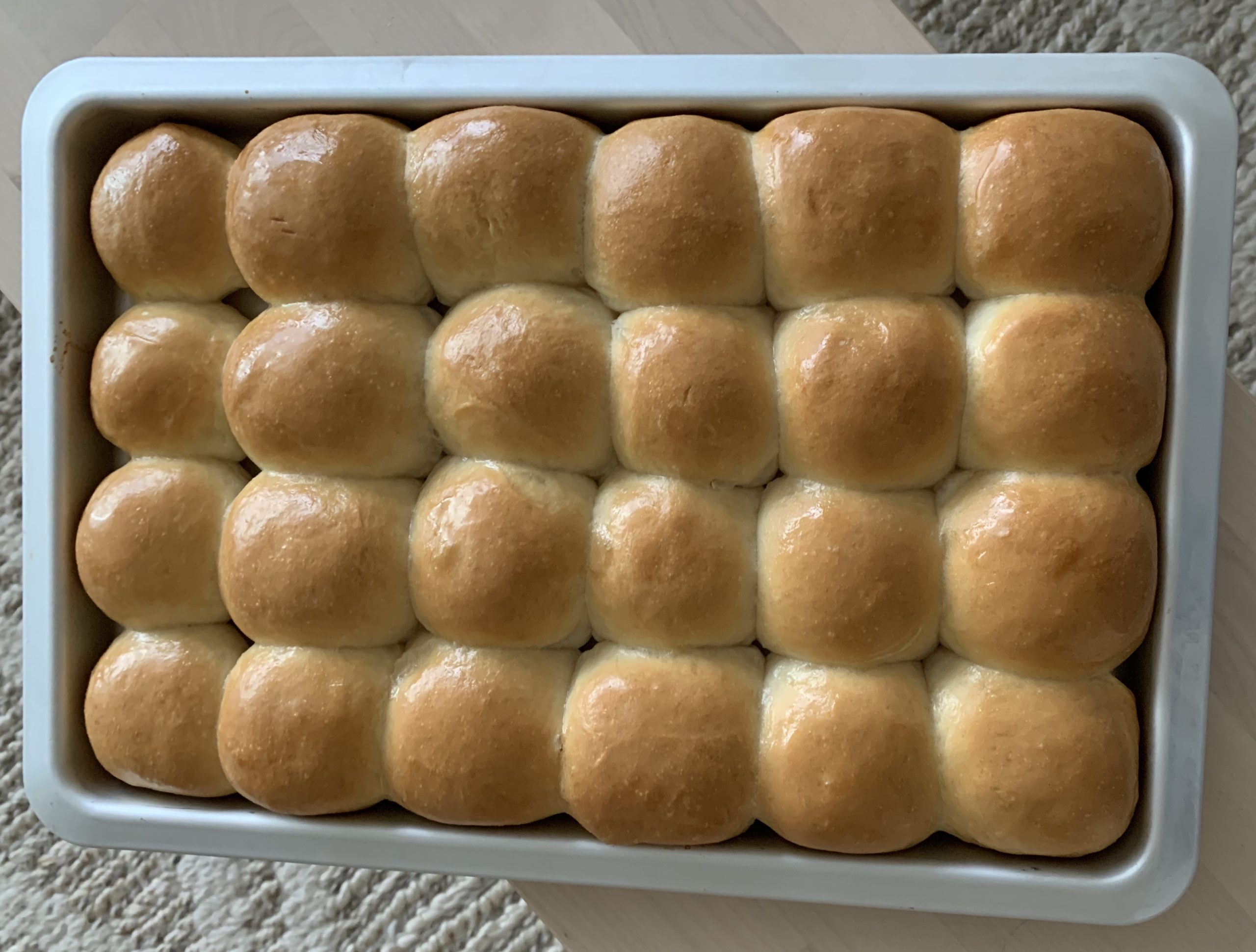Pav – Laadi pav

Indian bread rolls – popular accompaniment with street foods such as Pav bhaji, batata vada and misal!
I have been trying to make Pav for years. I have tried 100s of recipes – Recipes with milk powder, eggs, butter, crisco, margarine, fresh yeast, dry yeast, instant yeast, all purpose flour, bleached flour, unbleached flour… you name it! And needless to say, I’ve had all kinds of failures that you can imagine with bread-baking – underbaked pavs, pavs that just would not brown on top, burnt pavs, pavs so dense, they felt like rocks (that I could throw at someone or play catch with), too sweet, too greasy, egg-y smell, burnt.. gosh the torture..
I am actually impressed with my perseverance to keep at it for almost a decade! I can now proudly say that I have concocted a recipe that checks all the boxes for me. I went all food scientist on it – adjusted the yeast to flour to water ratio from all my failed experiments, figured the right amount of sugar to feed the yeast but not leave a sweet taste and enough salt to make the pav taste salty delicious but not inhibit the yeast.
This recipe is made with the kneading method. I also have another recipe with the stretch and fold method, which gives an even better result, but is a bit challenging if you dont like working with sticky, high hydration dough.
**NOTE** Although this recipe calls for milk, you can just use water in its place, and it turns out just fine, just a slight difference in body and aroma.
I strongly urge you to read both the recipes and decide, which one you feel more up to! Here’s a link to the other recipe!
Ironically, the end result is one of the simplest most effortless of all the recipes I have tried! And there you have it the perfect pav recipe:
You will need:
*NOTE* For some ingredients, I have linked the brand/ specific kind that I use for your convenience. By clicking on the link, you will be directed to another recipe on my website or to Amazon.com.
2 1/2 cups of bread flour (All purpose flour should be fine too, will just need longer kneading)
1 sachet of rapid rise instant yeast – 7 gms (I used fleischmann rapid rise)
1/2 cup tepid warm water (should just barely be warm to touch – 43 C or 110 F)
1/2 cup room temperature milk
1/4 up oil (any oil thats suitable for baking/ frying, I used baking olive oil, not extra virgin)
2 teaspoons sugar
1 1/2 teaspoons of salt
A baking tray
butter for greasing
Procedure:
- Add 2 tsp sugar to the warm water and milk and add a packet of instant yeast. Let stand for 5 min
- 1/4 cup cooking oil to the yeast mixture
- In a separate bowl, Mix together 2 1/2 cups of bread flower and 1 1/2 tsp of salt
- Mix the wet and dry ingredients and knead together – until dough comes together in a smooth ball that springs back when you poke it.
- If you use bread flour, you will have to knead for about 10 minutes. If you use a weaker flour such as APF, you might have to knead a bit longer. I personally find using bread flour incredibly more advantageous than regular flour.
- Put the ball of dough in an oiled bowl covered with a towel in a warm spot and let prove for 1 hour – 1st proving
- After one hour the dough should have more than doubled in size. punch it down, and make a ball again and leave back to prove for another 30 minutes, no kneading required – second proving
- remove the ball of dough and roll it out in a long cylinder and cut into 18-24 equal portions (depending on the size you want your pavs to be)
- Grease a baking sheet with some butter. Roll each portion into a ball by tucking the dough under. flatten each ball of dough (to make flat pavs) and place them slightly spaced apart on the greased sheet
- Cover with a kitchen towel and let prove for 45 minutes – third proving
- Preheat oven to 375 F.
- Brush the tops of the bread rolls with a mixture of milk and melted butter (2 tsbsp molten butter+2 tbsp milk).
- Bake at 375 F for 25-30 minutes
- as soon as they are out of the oven, smother them with some molten butter or some oil
- Remove from the baking tray on to a wire rack, keep covered while they cool to prevent drying
Follow these tips to get even better results:
- I proved my dough (all three times) in an oven with the light on with a large tray or tin of hot water on the bottom of the oven
- Make sure the bowl you are using to prove the first two times is warm. cold steel/ metal is not encouraging for the dough to rise.
- After the pavs are out of the oven, and cooling on the wire rack, cover them with a steamy hot towel while they cool to not let the tops harden
- I tried making this rcipe with 1 1/2 cup bread floyr and 1 cup sifted whole wheat flour (atta) and it worked quite well! The taste and color were obviously different however the texture was surprisingly quite similar.